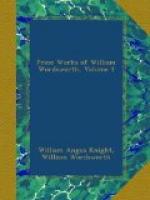From impressions of sight we will pass to those of sound; which, as they must necessarily be of a less definite character, shall be selected from these volumes:
Over his own sweet voice the Stock-dove broods;
of the same bird,
His voice was buried
among trees.
Yet to be come at by the breeze;
O, Cuckoo! shall I call thee
Bird,
Or but a wandering Voice?
The stock-dove is said to coo, a sound well imitating the note of the bird; but, by the intervention of the metaphor broods, the affections are called in by the imagination to assist in marking the manner in which the bird reiterates and prolongs her soft note, as if herself delighting to listen to it, and participating of a still and quiet satisfaction, like that which may be supposed inseparable from the continuous process of incubation. ’His voice was buried among the trees,’ a metaphor expressing the love of seclusion by which this Bird is marked; and characterising its note as not partaking of the shrill and the piercing, and therefore more easily deadened by the intervening shade; yet a note so peculiar and withal so pleasing, that the breeze, gifted with that love of the sound which the Poet feels, penetrates the shades in which it is entombed, and conveys it to the ear of the listener.
Shall I call thee Bird,
Or but a wandering Voice?
This concise interrogation characterises the seeming ubiquity of the voice of the cuckoo, and dispossesses the creature almost of a corporeal existence; the Imagination being tempted to this exertion of her power by a consciousness in the memory that the cuckoo is almost perpetually heard throughout the season of spring, but seldom becomes an object of sight.
Thus far of images independent of each other, and immediately endowed by the mind with properties that do not inhere in them, upon an incitement from properties and qualities the existence of which is inherent and obvious. These processes of imagination are carried on either by conferring additional properties upon an object, or abstracting from it some of those which it actually possesses, and thus enabling it to re-act upon the mind which hath performed the process, like a new existence.
I pass from the Imagination acting upon an individual image to a consideration of the same faculty employed upon images in a conjunction by which they modify each other. The Reader has already had a fine instance before him in the passage quoted from Virgil, where the apparently perilous situation of the goat, hanging upon the shaggy precipice, is contrasted with that of the shepherd contemplating it from the seclusion of the cavern in which he lies stretched at ease and in security. Take these images separately, and how unaffecting the picture compared with that produced by their being thus connected with, and opposed to, each other!




